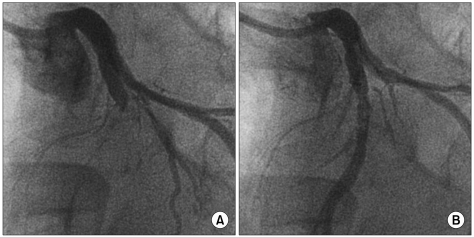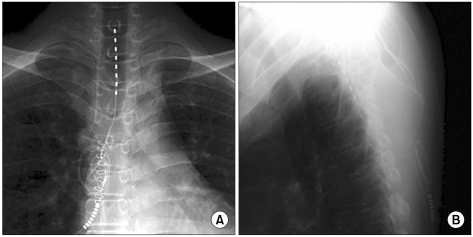Korean J Pain.
2012 Apr;25(2):121-125. 10.3344/kjp.2012.25.2.121.
Spinal Cord Stimulation for Refractory Angina Pectoris: A Case Report
- Affiliations
-
- 1Department of Anesthesiology and Pain Medicine, Chonnam National University Medical School, Gwangju, Korea. kimwm@jnu.ac.kr
- KMID: 1778998
- DOI: http://doi.org/10.3344/kjp.2012.25.2.121
Abstract
- Refractory angina pectoris is defined as angina refractory to optimal medical treatment and standard coronary revascularization procedures. Despite recent therapeutic advances, patients with refractory angina pectoris are not adequately treated. Spinal cord stimulation is a minimally invasive and reversible technique which utilizes electrical neuromodulation by means of an electrode implanted in the epidural space. It has been reported to be an effective and safe treatment for refractory angina pectoris. We report a case of spinal cord stimulation which has effectively relieved chest pain due to coronary artery disease in a 40-year-old man. This is the first report of spinal cord stimulation for treatment of refractory angina pectoris in South Korea.
MeSH Terms
Figure
Cited by 1 articles
-
Burst stimulation for refractory angina pectoris - A case report -
Daehun Yun, Kaehong Lee, JI Soo Kwak, Leegyeong Je, Taesan Kim, Yoon Sun Park, Jae Chul Koh
Anesth Pain Med. 2023;18(3):302-306. doi: 10.17085/apm.23020.
Reference
-
1. Mannheimer C, Camici P, Chester MR, Collins A, DeJongste M, Eliasson T, et al. The problem of chronic refractory angina; report from the ESC Joint Study Group on the Treatment of Refractory Angina. Eur Heart J. 2002; 23:355–370. PMID: 11846493.
Article2. Andréll P, Yu W, Gersbach P, Gillberg L, Pehrsson K, Hardy I, et al. Long-term effects of spinal cord stimulation on angina symptoms and quality of life in patients with refractory angina pectoris--results from the European Angina Registry Link Study (EARL). Heart. 2010; 96:1132–1136. PMID: 20483898.
Article3. Yu W, Maru F, Edner M, Hellström K, Kahan T, Persson H. Spinal cord stimulation for refractory angina pectoris: a retrospective analysis of efficacy and cost-benefit. Coron Artery Dis. 2004; 15:31–37. PMID: 15201618.
Article4. de Jongste MJ, Hautvast RW, Hillege HL, Lie KI. Efficacy of spinal cord stimulation as adjuvant therapy for intractable angina pectoris: a prospective, randomized clinical study. Working Group on Neurocardiology. J Am Coll Cardiol. 1994; 23:1592–1597. PMID: 8195519.
Article5. Eddicks S, Maier-Hauff K, Schenk M, Müller A, Baumann G, Theres H. Thoracic spinal cord stimulation improves functional status and relieves symptoms in patients with refractory angina pectoris: the first placebo-controlled randomised study. Heart. 2007; 93:585–590. PMID: 17237126.
Article6. Börjesson M, Andrell P, Lundberg D, Mannheimer C. Spinal cord stimulation in severe angina pectoris--a systematic review based on the Swedish Council on Technology assessment in health care report on long-standing pain. Pain. 2008; 140:501–508. PMID: 19004553.
Article7. Taylor RS, De Vries J, Buchser E, Dejongste MJ. Spinal cord stimulation in the treatment of refractory angina: systematic review and meta-analysis of randomised controlled trials. BMC Cardiovasc Disord. 2009; 9:13. PMID: 19320999.
Article8. Lanza GA. Cardiac syndrome X: a critical overview and future perspectives. Heart. 2007; 93:159–166. PMID: 16399854.
Article9. Svorkdal N. Treatment of inoperable coronary disease and refractory angina: spinal stimulators, epidurals, gene therapy, transmyocardial laser, and counterpulsation. Semin Cardiothorac Vasc Anesth. 2004; 8:43–58. PMID: 15372127.
Article10. Shealy CN, Mortimer JT, Reswick JB. Electrical inhibition of pain by stimulation of the dorsal columns: preliminary clinical report. Anesth Analg. 1967; 46:489–491. PMID: 4952225.11. Ubbink DT, Vermeulen H. Spinal cord stimulation for critical leg ischemia: a review of effectiveness and optimal patient selection. J Pain Symptom Manage. 2006; 31:S30–S35. PMID: 16647594.
Article12. Kemler MA, Barendse GA, van Kleef M, de Vet HC, Rijks CP, Furnée CA, et al. Spinal cord stimulation in patients with chronic reflex sympathetic dystrophy. N Engl J Med. 2000; 343:618–624. PMID: 10965008.
Article13. Kumar K, Taylor RS, Jacques L, Eldabe S, Meglio M, Molet J, et al. Spinal cord stimulation versus conventional medical management for neuropathic pain: a multicentre randomised controlled trial in patients with failed back surgery syndrome. Pain. 2007; 132:179–188. PMID: 17845835.
Article14. Mannheimer C, Eliasson T, Andersson B, Bergh CH, Augustinsson LE, Emanuelsson H, et al. Effects of spinal cord stimulation in angina pectoris induced by pacing and possible mechanisms of action. BMJ. 1993; 307:477–480. PMID: 8400930.
Article15. Gibbons RJ, Abrams J, Chatterjee K, Daley J, Deedwania PC, Douglas JS, et al. ACC/AHA 2002 guideline update for the management of patients with chronic stable angina-summary article: a report of the American College of Cardiology/American Heart Association Task Force on Practice Guidelines (Committee on the Management of Patients With Chronic Stable Angina). Circulation. 2003; 107:149–158. PMID: 12515758.
Article16. Melzack R, Wall PD. Pain mechanisms: a new theory. Science. 1965; 150:971–979. PMID: 5320816.
Article17. Diedrichs H, Zobel C, Theissen P, Weber M, Koulousakis A, Schicha H, et al. Symptomatic relief precedes improvement of myocardial blood flow in patients under spinal cord stimulation. Curr Control Trials Cardiovasc Med. 2005; 6:7. PMID: 15943878.
Article18. Foreman RD, Linderoth B, Ardell JL, Barron KW, Chandler MJ, Hull SS Jr, et al. Modulation of intrinsic cardiac neurons by spinal cord stimulation: implications for its therapeutic use in angina pectoris. Cardiovasc Res. 2000; 47:367–375. PMID: 10946073.
Article
- Full Text Links
- Actions
-
Cited
- CITED
-
- Close
- Share
- Similar articles
-
- Burst stimulation for refractory angina pectoris - A case report -
- Spinal Cord Stimulation in Pain Management: A Review
- Experience of Right Leg Pain Control by Left Epidural Space Inserted Spinal Cord Stimulator: A case report
- An Unexpected Improvement of the Symptom from Herniated Intervertebral Disc during Trial of Spinal Cord Stimulation for the Post-herpetic Neuralgia: A case report
- A Case of Polycythemia Vera Presenting with Angina Pectoris without Coronary Artery Stenosis



